Planting Pomegranate Trees: How To Grow A Pomegranate Tree From Seeds


Questions about how to plant a pomegranate seed show up quite frequently lately. The apple-sized fruit is now a regular addition to the fresh fruit department at the grocery, where once it was only seen during the winter holidays.
Along with the rise in popularity in recent years, seeing the abundance of seeds that lie beneath that ruby skin is enough to make any gardener wonder about growing pomegranate from seeds.
History of Planting Pomegranate Trees
The pomegranate is an ancient fruit native to Persia, in what is now modern day Iran. Once the plants were discovered by travelers, people were quickly planting pomegranate trees throughout the regions of Asia, Africa, and Europe surrounding the Mediterranean Sea.
Over the millennia, the luscious fruit has worked its way into the mythology of the Egyptians, Romans, and Greeks; been praised in both the Bible and Talmud; and featured in major works of art. One can almost hear the traders along the ancient Silk Road trade route asking questions about how to grow a pomegranate tree and how to market this remarkable fruit.
Over the ensuing years, the pomegranate became the fruit of royalty. This rich history, steeped in myth and romance, can probably be attributed to the fruit's uniqueness; for it is truly unique. The pomegranate, Punica granatum, belongs to a family of plants that has only one genus and two species - the other only found on the island of Socotra, an island in the Indian Ocean.
Although the Romans declared it an apple, when we talk about growing pomegranate from seeds, we need to recognize that this fruit is actually a berry. Inside the hard rind are sections called locules. These locules are separated by a thin white, bitter-tasting membrane. Inside the locules are the arils, jewel-like pearls of sweetness, each carrying both juice and seed.
How to Grow a Pomegranate Tree from Seeds
There isn't much to say about how to plant a pomegranate seed since these seeds sprout readily without too much help. The seeds should be cleaned of the fleshy aril surrounding them and should be planted in loose soil with a covering layer about a 1/2 inch (1.5 cm).
Gardening tips, videos, info and more delivered right to your inbox!
Sign up for the Gardening Know How newsletter today and receive a free download of our most popular eBook "How to Grow Delicious Tomatoes."
Heat should be second on your pomegranate seed care list. These seeds will germinate at normal room temperature in about 30-40 days. Bring the soil temperature up a few degrees and you can cut this time in half. Try surrounding your plant with foil and placing it in direct sun until the seedlings sprout.
There is another method that should be mentioned when describing how to plant a pomegranate seed. It's called the baggie method. Some gardeners swear by this method for growing pomegranate from seeds. Wet a coffee filter and wring out the excess water. Sprinkle the cleaned seed on one quarter of the filter. Carefully fold the filter into quarters and slide it into a sealable plastic bag. Store in a warm place and check the bag every few days for germination.
Once the pomegranate seeds sprout, transfer them to a pot. Use any small container that has good drainage and plant two to three seeds per pot. You can pinch off the weaker seedlings after they are a few weeks old or transplant them to their own pot. That's it!
Caring for Pomegranate Tree Saplings
But, if you want to know how to grow a pomegranate tree that is healthy and strong, the trick is in pomegranate care. In their natural habitats, the calcareous or chalky, alkaline soil is perfect for planting pomegranate trees, so for you, pomegranate care should begin with the planting medium.
The soil or planting media should be slightly alkaline with a pH up to 7.5. Since most planting mediums are developed to fall in the neutral range, the addition of a very small amount of limestone or garden lime to the mix should be sufficient.
Now that you know how to grow a pomegranate tree from seed, you should be aware that your seeds may not grow true to the cultivar it came from.
Still, your new pomegranate tree will produce fruit in one to three years and nothing tastes better than something you have grown yourself.

Jackie Rhoades began writing for Gardening Know How in 2010.
-
 "My Worst Mistake" – Gardeners Share 10 Hard-Learned Lessons
"My Worst Mistake" – Gardeners Share 10 Hard-Learned LessonsGardeners never stop learning, and sometimes our mistakes are the best teachers. But why not save time and heartache by learning from other gardeners' failures?
By Melanie Griffiths
-
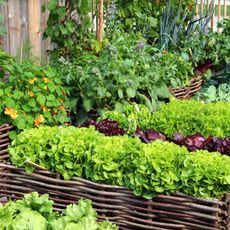 Crops for Urban Growing: 8 Edible Plants For Urban Gardens
Crops for Urban Growing: 8 Edible Plants For Urban GardensUrban edible gardening lets your yard do double duty of beauty and practicality. Have fun combining edible plants with ornamentals.
By Teo Spengler
-
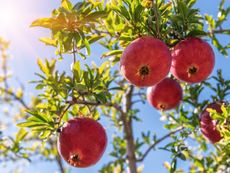 Replanting Container Grown Pomegranate – Tips On Transplanting Potted Pomegranates Outside
Replanting Container Grown Pomegranate – Tips On Transplanting Potted Pomegranates OutsideIt’s pretty easy to transplant a potted pomegranate outdoors. Click for more information on moving a potted pomegranate.
By Teo Spengler
-
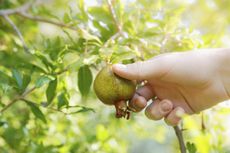 Picking Pomegranates – Learn About Harvesting Pomegranate Fruit
Picking Pomegranates – Learn About Harvesting Pomegranate FruitPomegranates have become so popular that many people in USDA zones 7-10 are trying their hand at growing and picking their own pomegranates. So how and when do you harvest pomegranates? Click this article to learn more.
By Amy Grant
-
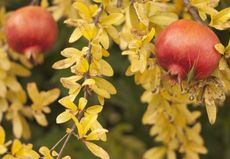 Yellowing Leaves On Pomegranate: Why Pomegranate Leaves Turn Yellow
Yellowing Leaves On Pomegranate: Why Pomegranate Leaves Turn YellowGrowing a pomegranate tree can be a rewarding experience filled with delicious fruits and beautiful juice, but growing these fruit trees isn't all paradise. If your plant is looking a little off, with yellowing leaves, click here to learn how to save it.
By Kristi Waterworth
-
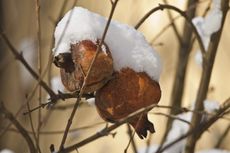 Pomegranate Winter Care: How To Care For Pomegranate Trees In Winter
Pomegranate Winter Care: How To Care For Pomegranate Trees In WinterPomegranates hail from the far eastern Mediterranean so as you may expect they appreciate plenty of sun and should be protected in the winter time. How do you go about overwintering pomegranate trees? Find out in this article.
By Amy Grant
-
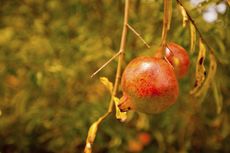 Pomegranate Tree Leaves Falling Off: Why Do Pomegranate Trees Lose Leaves
Pomegranate Tree Leaves Falling Off: Why Do Pomegranate Trees Lose LeavesPomegranates are typically grown for their fleshy, sweet-tart edible fruits. That being said, pomegranate leaf loss can be a frustrating problem for many gardeners. Click on the article that follows to learn why this happens.
By Karen Boness
-
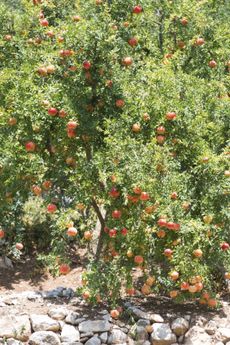 Pomegranate Tree Pruning – Learn About The Cutting Of Pomegranates
Pomegranate Tree Pruning – Learn About The Cutting Of PomegranatesIt is important to prune pomegranate trees properly if you want to increase fruit production and maintain an attractive form. Unfortunately, these two goals are in conflict. Learn more about pruning pomegranates in this article.
By Karen Boness
-
 Propagating Pomegranate Trees: How To Root A Pomegranate Tree
Propagating Pomegranate Trees: How To Root A Pomegranate TreeGrowing a pomegranate tree from cuttings is cost-free and relatively easy. Find more information about how to root a pomegranate tree from pomegranate tree cuttings in the article that follows. Click here to learn about pomegranate propagation.
By Teo Spengler
-
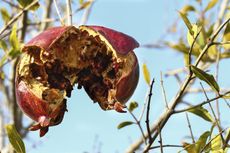 Problems Of Pomegranates: Learn About Diseases In Pomegranate
Problems Of Pomegranates: Learn About Diseases In PomegranatePomegranate fungal diseases are a common issue in plants grown in wet regions. Other diseases in pomegranate are rarer and not permanently damaging to the tree. Learn the problems of pomegranates in this article. Click here for more info.
By Jackie Carroll